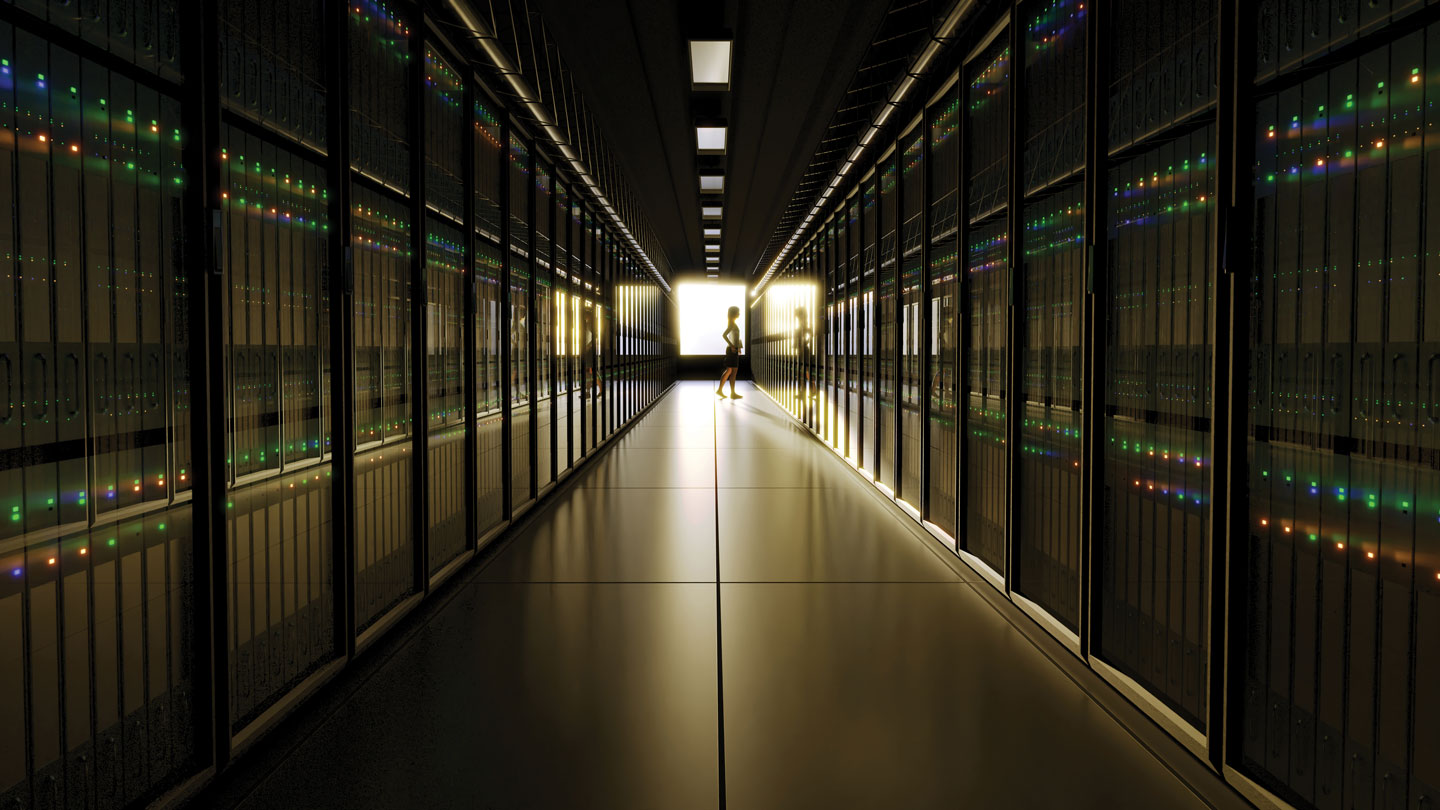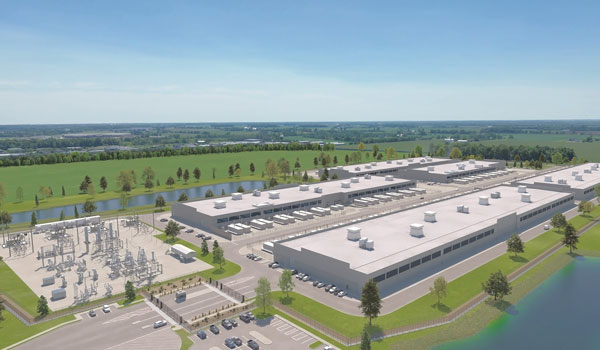
Challenges and Opportunities in Mission Critical Development
Peter Hansen via iStock/Getty Images Plus
The promise of functional AI has added complexity and urgency to the delivery of data centers.
Since 1992, Ryan Companies has built mission critical data centers. Currently, the company is building or developing more than $5 billion in data center projects across the United States. Todd Johnson, director of real estate development for Ryan’s mission critical sector, recently sat down for an interview to discuss the complexities of this fast-growing area of specialization.
Development: For those who don’t know or are unclear, can you describe common or popular types of mission critical projects?
Johnson: “Mission critical” refers to any project that requires minimal downtime and failure, as people depend on it to some extent. Examples include operating rooms, data centers and laboratories.

Todd Johnson began working in hyperscale data center development in 2016. Courtesy of Ryan Companies
There is a significant level of detail involved not just in the planning stages and in securing the necessary infrastructure, including its redundancy, but also in the execution phase. Safety, quality assurance and meticulous attention to detail are crucial in how everything is assembled. All these aspects must be 100% accurate, and the client is closely observing the process to ensure that all components are aligned with their needs and goals.
Development: What drew you to mission critical real estate?
Johnson: I have been in commercial real estate for 34 years as a developer, broker and corporate real estate professional in various roles and companies. In 2016, my neighbor worked as a transaction manager for a company with a worldwide presence in cloud computing solutions. I had no idea what it all entailed, but in researching the broader cloud computing industry, I found it very intriguing. So on Halloween 2016, I started my adventure in hyperscale data center development on the user/tenant developer side.
Fast-forward to March 2024, and it was time to find a new opportunity. I was considering making the logical transition to the third-party development side of things. I determined Ryan was best positioned because of the people it had in place, the reach of its 17 offices across the country and its capabilities. I took it as a gentle nudge that Ryan has been in the mission critical sector for as long as I have been in commercial real estate.
Development: Please describe what Ryan is doing now in the mission critical space.
Johnson: Mission critical brings the level of detail and failproof to a higher standard. Ryan has rolled with the trends in data centers, first building on-premises data centers, engaging in MEP (mechanical, electrical and plumbing) upgrades, and building a prototype freestanding data center for a top tech company. In 2023, the fuse was lit on AI, and Ryan jumped to building full campuses of hyperscale data centers with a scope that included the full shell and MEP buildouts. Ryan is now underway on multiple campuses exceeding 1 million square feet across the United States. We are present in the various components of mission critical development. We have ground-up developments happening in multiple states. We also have $2.5 billion in ongoing third-party general contracting work building hyperscale data center campuses.
But our approach is unique because we are not just building the shell; we are building the project starting at the electrical feeders that come from the substation, the site work, the medium-voltage switchyard, the MEP serving the data halls, the racking for the data halls, right down to the whips (the power source for the servers). We currently have 27 projects in our portfolio.
Development: What are some of the challenges associated with mission critical work?
Johnson: There are unique challenges with mission critical projects, including power availability. The more significant challenge with getting developments built and rent flowing is the lack of the most critical equipment needed: electrical gear. For most buyers, there is a minimum three-year delay — and as much as five years in some instances — for necessary components. However, there’s often an opportunity to prioritize your project to find new suppliers and to accelerate your time frame through leveraging the client’s supply chain advantages.
Development: What key factors contribute to the successful development of mission critical projects?
Johnson: The most important aspect is not to assume you know what the customer wants. There are some basics, but beyond that, you should be open and flexible to what the customer needs to be successful and timely. Of course, communication is key to unlocking and navigating toward a successful outcome.
Development: What trends do you currently see or predict in the future regarding the mission critical space?
Johnson: There will be some fallout of companies trying to chase this product. There’s a lot of money being thrown at the segment right now to buy land, leading to overpaying and assuming risk that will often lead to project failure. It is important to understand this early on so we don’t get caught up in the fever. Don’t follow others; lead with solutions and focus on relationships.
Understanding the current and potential future issues related to hyperscale development is essential. For instance, despite the general optimism, I must highlight the challenge of long lead times for essential equipment. If we don’t address this issue proactively, we risk delayed rent starts. It’s important that we confront this situation directly and in advance.
Companies that adopt the right practices will find significant opportunities. However, identifying the issues can be challenging. Due to the rapidly evolving nature of this business, there is no definitive playbook.
Development: Why is there such a long wait time for electrical gear and other components needed for mission critical projects?
Johnson: Late 2022 marked a turning point in demand for AI infrastructure, spurred by the capabilities of ChatGPT, which caught Wall Street’s attention. This prompted a scramble for resources as AI demand surged, increasing at least fivefold compared to the previous data center boom. The equipment shortage arose from unpreparedness for this rapid growth, leading the Big 5 users — AWS, Microsoft, Google, Oracle, and Meta — to dominate supplier production and help build new production lines. While long lead equipment timelines extend, I remain optimistic that the marketplace will eventually resolve these challenges.
Development: Where do investors stand on AI?
Johnson: One major question for Wall Street and end users is the return on investment for AI. Businesses often wonder if a $10 million investment can yield $50 million. But unlike traditional software, AI gives us proactive engagement in achieving results.
I’ve gathered grassroots data by talking to industry professionals about successful AI use cases. The feedback has been overwhelmingly positive. It demonstrates that AI can truly implement strategies that help achieve goals.
Customer success is now a key focus for software firms, and AI inherently learns to optimize outcomes. The challenge lies in guiding users and anticipating their needs, which AI does effectively address.
Development: What types of data centers is Ryan focused on building?
Johnson: We want to focus on three types:
- Original cloud data centers close to metro areas. Referred to as core data centers, they traditionally host websites and provide cloud services.
- AI data centers, which are geographically unconstrained. These data centers do not necessarily have latency concerns. They can operate anywhere that is served by the appropriate power and other related infrastructure.
- Edge data centers, which are smaller 10,000- to 50,000-square-foot data centers. These are intended for the Big 5 to extend their reach without building full regions. An edge building can be a physical presence in a small market, which brings a more complete product offering closer to the users.
Development: Why is the timing right for mission critical pursuits?
Johnson: To allow the AI opportunity to play out, we need to build data centers. Certainly the money is being invested already. Will there be an oversupply later? Possibly, but we won’t see it anytime soon.
Development: How is Ryan dealing with these projects’ sustainability challenges and requirements?
Johnson: The Big 5 users each have individual sustainability goals and are committed to finding solutions for achieving net-zero power and net-positive water. Ryan works closely with these partners to support their sustainability objectives, exploring opportunities early on and assessing potential impacts.
For instance, in our largest development project, we conducted a water study to identify sustainable water sources that do not harm aquifers. The study provided valuable information to potential users, including maintaining water usability that allows for recycling in irrigation or industrial applications.
Development: How does Ryan create programmatic solutions that ensure consistency and incorporate lessons learned from previous projects?
Johnson: The mission critical space is not like working on logistics facilities where the processes are roughly the same user to user. Each of the Big 5 has a unique approach to overall data center design, and every step in the process is like that. However, due to the low number of users, and the volume and demand, a programmatic approach per user works well.

A rendering of a data center campus from Ryan Companies, which has 27 mission critical projects in its portfolio. Courtesy of Ryan Companies
Our clients have specific criteria for judging performance and how much innovation we bring to the project. For example, there were not enough local electricians available to service a project. So, we convinced a client to put all the electrical room gear on a skid and assemble it off-site to save on electrician hours on-site.
Development: How do mission critical projects make a positive impact in communities?
Johnson: The real estate projects have a very high dollar value, so even after economic incentives are given, the value is mainly in the revenue generated from taxing the asset. Data center jobs have a notoriously low head count, but the jobs themselves are high value and put those employees on a career track to even higher-value roles within the tech ecosystem. Another positive is that these projects don’t require communities to construct new schools and roads. The things that are needed are very specific infrastructure items. Because of the low traffic volume, there is little impact on adjacent neighborhoods.
Development: What does Ryan do for community outreach?
Johnson: Our team prioritizes listening to and communicating with the community to effectively address their questions, needs and concerns. Education is crucial, as many people find the term “data center” unclear. We aim to clarify what a data center is in terms of its size, appearance and purpose while highlighting the economic benefits it brings. We want to answer important questions like, “What advantages does your presence bring to our community?”
We engage with city officials early and often, sharing our vision through visual site plans. We value their insights about sensitive areas and actively seek opportunities to develop beautiful projects. Our mission is to empower the community through knowledge, fostering a sense of partnership and possibility.




